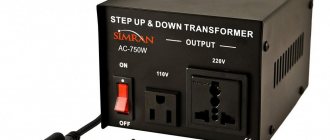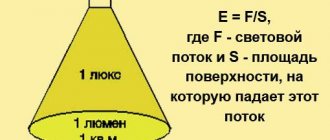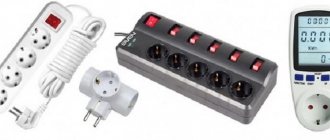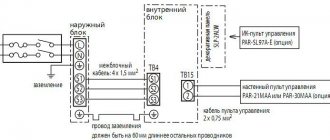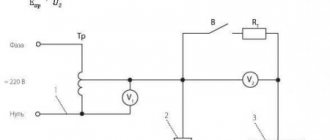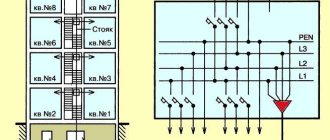What are watt and volt
1 volt is equal to a unit of voltage created by an electric current at the ends of a conductive device designed to produce 1 watt of heat at a constant electrical characteristic passing through the conductor. The volt characteristic is also defined as the potential difference between two measured points when a charge of one coulomb moves from point A to point B, when work of 1 joule is required.
Volts, watts and amps
1 W is an indicator of power at which work equal to 1 J is performed per second. It turns out that W is considered a derivative of two quantities. Power and voltage have a relationship:
1W = 1V*1A
Formulas
To have an idea of what power is, you need to think logically. If we assume that it is simply force, such a conclusion will be incorrect. To correctly evaluate a physical quantity, it is enough to know that power is the rate at which a device consumes energy.
For example, a lamp can produce bright or dim light, depending on the rate at which energy is consumed. If the brightness is higher, then the consumption is higher, and vice versa.
Attention! The power rating applies to all electrical appliances, but it is not always related to electricity. This is the main difference between the indicators.
Basic current values
Power also comes in:
- Thermal – determined by temperature parameters.
- Electrical – the indicator is taken into account in electrical appliances, including light bulbs.
- Mechanical, determined by the number of horsepower.
All of the above refers to physical characteristics.
You may be interested in Features of the designation of radio components on the diagram
What is the difference between a Volt and a Watt?
One of the main characteristics of any electrical equipment is voltage and power consumption, and therefore on any device (or in its passport) there is information about power (Watt) and voltage (Volt).
Definition
Watt (W or W) is a unit of measurement of power.
Volt (V or V) is a unit of measurement of electrical potential, voltage, potential difference, and electromotive force.
Comparison
Volts and Watts are units of measurement for various electrical parameters.
1 Volt is the amount of electrical voltage at the ends of the conductor required to release heat with a power equal to 1 Watt with a constant electric current flowing through this conductor equal to one Ampere. Also, 1 Volt can be characterized as the difference in electrical potential between two existing points in the case when, to move an electric charge of 1 Coulomb from point to point, work equal to 1 Joule is required.
1 Watt is the amount of power at which work equal to one Joule is performed in one second. Therefore, Watt is a unit derived from other quantities. So, for example, power is related to voltage as follows: W = V•A, where B is an indicator of the voltage value, and A is an indicator of the current value. In addition to mechanical power, a distinction is also made between electrical and thermal power.
Conclusions TheDifference.ru
- Watt (W or W) is a standard unit of measurement of power.
- Volt (V or V) is a standard unit of measurement for voltage, electrical potential difference, electrical potential, and electromotive force.
- The power (W) of any device can be calculated by multiplying the voltage (V) by the current (A). AMPERE (A) is a standard unit of measurement of electric current.
thedifference.ru
How are they designated?
W is a watt or a volt, some find it difficult to answer. The designation W was noted already in the century before last in Great Britain. The name of the measure was given in honor of the famous scientist, ideologist of the industrial revolution, James Watt, who was also the creator of the first steam engine.
He spent many years studying this indicator and used horsepower to measure it.
Volt is a unit named after the great physicist Alessandro Volta. A volt is defined as the difference in voltage or potential at the ends of a conductor, as well as between conductive sections of a circuit.
Designation of quantities:
- W – watt
- V – volt.
It is an accepted abbreviation (abbreviation) in the international system.
What is the difference between W and V (V and A)
What is the difference between a volt and an ampere: Volt is a unit of measurement of voltage, and watt is a unit of power. V is the difference created in the electrical potential across a wire line when a current of 1A dissipates a unit of power, i.e. voltage. The definition of voltage is that it is the potential of electricity between different points. Along with this, it is used to indicate the difference in potential energy of an electric charge between points. An energy source is a voltage that represents expended or lost energy.
About power
Attention! Voltage is hypothetically similar to the pressure created in a circuit, pushing electrons through.
The passage of current must be ensured on two paths. This characteristic is considered the total energy for moving the charge. The definition of voltage is based on the fact that negative charges are attracted to high values, and positive charges to low values.
W – speed of work. The speed is maintained at 1 meter per second against a constant reaction force of 1 newton. If we consider it in relation to electromagnetism, the unit is the rate of work done when 1 ampere passes through a potential difference of 1V. Watt is a measure of power.
You may be interested in: Features of tantalum capacitors
Power
Power is the energy flow with which energy is consumed. It happens that in the description of a device it appears instead of kW - kVA. To determine this value, you need to know what is measured in kVA.
No energy is expended to complete the work, but on the contrary:
- One of the factions becomes active, that is, it performs work or transforms into another form.
- The other faction is reactive. The energy is directed into an electromagnetic field.
Attention! These quantities are different, despite the same proportionality. To avoid confusion, the indicator is measured not in watts, but in volt-amperes.
Mechanical power
Comparison
In order to understand the fundamental difference between the concepts of volt and watt, you need to make a comparison. As it became clear from the definitions, they are all used by physicists to determine the characteristics of electrical flows. The volt is a unit that allows you to accurately measure voltage, and the watt helps determine what power indicators are.
Volt indicates how much difference is created in the resulting electrical potential along the wire line. In this case, voltage should arise after a current with a certain strength cuts through a unit of power.
The definition of voltage is that it is nothing more than the potential of electricity. It occurs between different points, and not at one of them. Volt is used to indicate the difference in potential energy present in an electrical charge. It is present between the points. This point can be a wire, part, or battery. Also a source that operates using electricity. The source of energy in this case is voltage, which represents both expended and lost energy. This process can be compared to the pressure that inevitably occurs in the circuit to push electrons forward. In order to avoid problems with the operation of the power source, it is necessary to create conditions under which the two paths will have all the conditions for the unhindered passage of current. Total energy is generated, which is then spent on moving the charge. It is necessary to take into account the peculiarities of the physical elements. It lies in the fact that negative charges are attracted to high values. If there are positive ones, then attraction will occur to the lower ones.
You may also be interested: Municipal and public service - what are they and the differences
Watts measure the rate of work expended to maintain power levels at a certain level.
Voltage in watts or volts is measured according to individual criteria suitable for these physical quantities. Voltage measurements are carried out in Volts. If you need to create a drawing (scheme), then this unit will be indicated as V. Energy is expended to perform work, which is measured in Joules.
What voltage is measured in volts and watts
Voltage in watts or volts is measured according to individual criteria. Voltage measurements are carried out in Volts, and in the drawings it is indicated by the letter V. The voltage is measured by a device - a voltmeter. The latest devices may be:
- Analog.
- Digital.
The first ones are more accurate.
Portable devices have voltmeters built into them, and these tools are used by electricians. Analog devices are installed on electrical panels: switchboards and generators. The latest equipment comes complete with digital meters.
The voltage value in accordance with international standards is established:
- Kilovolt – kV.
- Millivolt – mV.
- Volt - V.
- Megavolt - MV.
- Microvolt - µV.
Voltage measurements
Important! Power is measured in watts (kilowatts). This value is directly proportional to the voltage, as well as to the magnitude of the current. The main difference is the designation of established indicators, according to the measurement system.
How to convert volts and watts and vice versa
To correctly complete the task associated with converting volts to watts, you can follow the following algorithm:
- You need to find the power value in the operating manual of the electrical appliance. Companies often indicate this value in volt-amperes. This symbol indicates the maximum amount of electricity consumed. So it is equal to the power value.
- Determine the efficiency of the power source based on the design features and the number of devices connected to it. As a rule, this coefficient is set in the range from 0.6 to 0.8.
- Convert current-voltage indicators to W: find out the active power of energy equipment designed to supply uninterruptible power.
You might be interested in DRL 400 lamp
Important! Calculate the number of watts by multiplying volt-amperes by efficiency.
Visual representation of voltage and current
- Conversion from W to V follows the reverse pattern: watts must be divided by the efficiency factor.
When choosing a power source from the manufacturer, it is not always clear how much power the device produces. Therefore, it is recommended to study the technical parameters specified in the instructions in order to carry out the correct conversion from one value to another.
To calculate the load on the electrical network and energy costs, you can use a special calculator for converting current to power. This function appeared recently, greatly facilitating manual determination.
Although the formulas have been known for a long time, not everyone knows physics well enough to independently determine the current strength in the network. The calculator helps with this, since it is enough to know the voltage and power to work.
Content
How to measure power in volt-amps
Knowing how to calculate the correspondence between amperes and watts is necessary in order to determine which device can withstand the power of connected consumers. Such devices include protective equipment or switching equipment.
Before choosing which circuit breaker or residual current device (RCD) to install, you need to calculate the power consumption of all connected devices (iron, lamps, washing machine, computer, etc.). Or, on the contrary, knowing the cost of a circuit breaker or protective shutdown device, determine which equipment will withstand the load and which will not.
To convert amperes to kilowatts and vice versa, there is a formula: I=P/U, where I are amperes, P are watts, U are volts. Volts are the mains voltage. In residential premises, a single-phase network is used - 220 V. In production, to connect industrial equipment, a three-phase electrical network is used, the value of which is 380 V. Based on this formula, knowing the amperes, you can calculate the correspondence to watts and vice versa - convert watts to amperes.
Situation: There is a circuit breaker. Technical parameters: rated current 25 A, 1-pole. You need to calculate what wattage of devices the machine can withstand.
The easiest way is to enter technical data into a calculator and calculate the power. You can also use the formula I=P/U, it will turn out: 25 A=x W/220 V.
x W=5500 W.
To convert watts to kilowatts, you need to know the following measures of power in watts:
- 1000 W = 1 kW,
- 1000 000 W = 1000 kW = MW,
- 1000,000,000 W = 1,000 MW = 1,000,000 kW, etc.
This means 5500 W = 5.5 kW.
Answer: a machine with a rated current of 25 A can withstand the load of all devices with a total power of 5.5 kW, no more. Copper conductors of wires and cables
| Core cross-section, mm² | Copper conductors of wires, cables | |||
| Voltage 220 V | Voltage 380 V | |||
| Current, A | power, kWt | Current, A | power, kWt | |
| 1,5 | 19 | 4,1 | 16 | 10,5 |
| 2,5 | 27 | 5,9 | 25 | 16,5 |
| 4 | 38 | 8,3 | 30 | 19,8 |
| 6 | 46 | 10,1 | 40 | 26,4 |
| 10 | 70 | 15,4 | 50 | 33 |
| 16 | 85 | 18,7 | 75 | 49,5 |
| 25 | 115 | 25,3 | 90 | 59,4 |
| 35 | 135 | 29,7 | 115 | 75,9 |
| 50 | 175 | 38,5 | 145 | 95,7 |
| 70 | 215 | 47,3 | 180 | 118,8 |
| 95 | 260 | 57,2 | 220 | 145,2 |
| 120 | 300 | 66 | 260 | 171,6 |
You need to convert watts to amperes in a situation where you need to install a protective device and you need to choose what rated current it should have. It is clear from the operating instructions how many watts a household appliance connected to a single-phase network consumes.
The task is to calculate how many amperes in watts or what kind of socket to connect to if the microwave oven consumes 1.5 kW. For ease of calculation, it is better to convert kilowatts into watts: 1.5 kW = 1500 W. We substitute the values into the formula and get: 1500 W / 220 V = 6.81 A. We round the values up and get 1500 W in terms of amperes - microwave current consumption is at least 7 A.
If you connect several devices simultaneously to one protection device, then in order to calculate how many amperes there are in watts, you need to add all the consumption values together. For example, the room uses lighting with 10 pcs LED lamps. 6 W, iron 2 kW and TV 30 W. First, all indicators need to be converted into watts, it turns out:
- lamps 6*10= 60 W,
- iron 2 kW=2000 W,
- TV 30 W.
60 2000 30=2090 W.
Now you can convert amperes to watts, to do this we substitute the values in the formula 2090/220 V = 9.5 A ~ 10 A. Answer: current consumption is about 10 A.
You need to know how to convert amps to watts without a calculator. The table shows the correspondence between the rate of electricity consumption and the current strength for single-phase and three-phase networks.
| Ampere (A) | Power, kWt) | |
| 220 V | 380 V | |
| 2 | 0,4 | 1,3 |
| 6 | 1,3 | 3,9 |
| 10 | 2,2 | 6,6 |
| 16 | 3,5 | 10,5 |
| 20 | 4,4 | 13,2 |
| 25 | 5,5 | 16,4 |
| 32 | 7,0 | 21,1 |
| 40 | 8,8 | 26,3 |
| 50 | 11,0 | 32,9 |
| 63 | 13,9 | 41,4 |
To correctly size, for example, a power supply, it is important to understand the difference between watts and volt-amps. Real power, measured in watts, is a portion of the energy flow consumed and is related to the resistance in an electrical circuit. An example of this is the filament in a light bulb.
Volt ampere conversion
Reactive power, measured in VAR or “volt ampere reactive”, is the portion P of stored energy flow. Stored energy is associated with the presence of inductance and capacitance in an electrical circuit. Apparent power, measured in V•A, is a mathematical combination of real and reactive P.
The geometric relationship between apparent, reactive and real power is defined by the triangle P. Mathematically, real power (W) is related to apparent power (V•A) using a numerical relationship called power factor (PF), which is expressed in decimal form and ranges from 0 to 1.0.
Since many types of equipment are rated at P in watts, it is important to consider PF when sizing a UPS. If PF is not taken into account, the size of the required UPS can be reduced. For example, a piece of equipment with a power of 525 W and a power factor of 0.7, which must be multiplied by the power, determines the minimum power with a load of 750 V•A.
750 V•A = 525 W / 0.7
If the UPS is rated at 75%, you will get a UPS rated 1000 V•A (750 VA / 0.75 = 1000 V•A).
What is power Watt [W]
Power is a quantity that determines the ratio of work performed by a current source over a certain period of time. One watt corresponds to the product of one ampere and one volt, but when determining energy costs, the value of kilowatt/hour .
It corresponds to the consumption of one thousand watts for 60 minutes of operation. It is by this indicator that the cost of electricity services is determined.
In most cases, the power consumed by the device is indicated in the technical documentation or on the packaging. The specified quantity is produced in one hour of work.
For example, a computer with a 500 W power supply will spin 1 kW for 2 hours of operation.
To help determine the current strength at a known power, a calculator will help, which converts one physical quantity to another.
How many watts in 1 ampere
There is no direct answer to this question, just as it is impossible to say how many meters are in a kilogram. These are different physical quantities. But those asking this question can be understood and the situation can be explained.
An electrical network that has a stable voltage, for example, 12 or 220 Volts, when loaded with a certain current, will produce a clearly known power. So there is still an answer.
P=U*I=12*1=12 W
For example, if you connect a light bulb that consumes 1 Ampere to a car, it will produce 12 Watts of power in the form of light and heat.
This can be calculated using a calculator or a table containing formulas known from physics.
Watt/Ampere conversion table
The table has a form in which the power values are located vertically, and the mains voltage is located horizontally. At the intersection of rows and columns there are numbers that have the dimension of current in Amperes.
| 6V | 12V | 24V | 220V | 380V | |
| 5 W | 0.83A | 0.42A | 0.21A | 0.02A | 0.008A |
| 6 W | 1.00A | 0.5A | 0.25A | 0.03A | 0.009A |
| 7 W | 1.17A | 0.58A | 0.29A | 0.03A | 0.01A |
| 8 W | 1.33A | 0.66A | 0.33A | 0.04A | 0.01A |
| 9 W | 1.5A | 0.75A | 0.38A | 0.04A | 0.01A |
| 10 W | 1.66A | 0.84A | 0.42A | 0.05A | 0.015A |
| 20 W | 3.34A | 1.68A | 0.83A | 0.09A | 0.03A |
| 30 W | 5.00A | 2.5A | 1.25A | 0.14A | 0.045A |
| 40 W | 6.67A | 3.33A | 1.67A | 0.13A | 0.06A |
| 50 W | 8.33A | 4.17A | 2.03A | 0.23A | 0.076A |
| 60 W | 10.00A | 5.00A | 2.50A | 0.27A | 0.09A |
| 70 W | 11.67A | 5.83A | 2.92A | 0.32A | 0.1A |
| 80 W | 13.33A | 6.67A | 3.33A | 0.36A | 0.12A |
| 90 W | 15.00A | 7.50A | 3.75A | 0.41A | 0.14A |
| 100 W | 16.67A | 3.33A | 4.17A | 0.45A | 0.15A |
| 200 W | 33.33A | 16.66A | 8.33A | 0.91A | 0.3A |
| 300 W | 50.00A | 25.00A | 12.50A | 1.36A | 0.46A |
| 400 W | 66.66A | 33.33A | 16.7A | 1.82A | 0.6A |
| 500 W | 83.34A | 41.67A | 20.83A | 2.27A | 0.76A |
| 600 W | 100.00A | 50.00A | 25.00A | 2.73A | 0.91A |
| 700 W | 116.67A | 58.34A | 29.17A | 3.18A | 1.06A |
| 800 W | 133.33A | 66.68A | 33.33A | 3.64A | 1.22A |
| 900 W | 150.00A | 75.00A | 37.50A | 4.09A | 1.37A |
| 1000 W | 166.67A | 83.33A | 41.67A | 4.55A | 1.52A |
For example, you need to find out what current will flow through the car starter at its maximum load, if the declared power is 1 kilowatt or 1000 watts.
At the intersection of the "1000 W" row and the "12 V" column, the value is 83.33 Amps. This will help when choosing wires; they should withstand such current without any significant losses.
What is Current Strength. Ampere [A]
Current is the speed at which electrical charge flows through a conductor. One ampere is equal to a charge of one coulomb that passes through a conductor in one second. One coulomb represents a very large charge, so in most devices this value is measured in milliamps.
The current strength depends on the cross-section of the conductor and its length. This must be taken into account when planning structures, as well as choosing electrical appliances. Although most should not think about this, since this is the task of engineers and designers.
How many watts are in 1 ampere?
To determine the power of a circuit, the concept of voltage is also important. This is the electromotive force that moves electrons. It is measured in volts. Most devices have this characteristic in their documentation.
To determine the power at a current of one ampere, you need to know the network voltage. So, for a 220 volt outlet it will be: P = 1 * 220 = 220 W. Formula for calculation: P = I*U, where I is current and U is voltage. In a three-phase network, a correction factor must be taken into account, reflecting the percentage of operating efficiency. In most cases it is between 0.67 and 0.95.
Object of measurement
To determine volt-amperes (V•A), you will need to perform the following measurements:
- First you will need to measure the current in amperes (A). This is the SI unit of I.
- Next, the voltage should be measured in SI units - volts. It will show the force required for the flow of electric current in volts (V).
- Calculate P - the amount of energy produced by current and volts together. Multiplying amperes (A) by volts (V) gives the resultant or energy.
Measuring quantities
Direct current (—), or DC, is inherent in the process when it flows in one direction, for example, a flashlight with a battery uses a constant indicator. Alternating current (~) or AC refers to processes with alternating direction of electron movement, due to which it periodically changes its direction. In North America and Western Japan this occurs 60 times per second at a frequency of 60 Hz. In Russia, the EU, most of Australia, South America, Africa and Asia, the frequency is 50 Hz.
Watt's law formula
Power (P) = Current (I) x Voltage (V), also in units: watt = ampere x volt. To find amplifiers, use the Watt formula in reverse and divide the power by the voltage: Current (I) = Power ( P) ÷ Voltage (V)I = 600 W : 120 V, then I value = 5A
Note! When specialists operate with large dimensions P, they use kilowatts (kW), 1 kW = 1000 W.
Ampere – Watt conversion table
To convert watts to amperes, you need to use the previous formula, expanding it. To calculate the current, you need to divide the power by the voltage: I = P/U. The following table shows the amperage for devices with different voltages - 6, 12, 24, 220 and 380 volts.
Remember that for high voltage networks, the specified amperage differs depending on the efficiency.
Table of the ratio of amperes and watts, depending on voltage.
| 6V | 12V | 24V | 220V | 380V | |
| 5 W | 0.83A | 0.42A | 0.21A | 0.02A | 0.008A |
| 6 W | 1.00A | 0.5A | 0.25A | 0.03A | 0.009A |
| 7 W | 1.17A | 0.58A | 0.29A | 0.03A | 0.01A |
| 8 W | 1.33A | 0.66A | 0.33A | 0.04A | 0.01A |
| 9 W | 1.5A | 0.75A | 0.38A | 0.04A | 0.01A |
| 10 W | 1.66A | 0.84A | 0.42A | 0.05A | 0.015A |
| 20 W | 3.34A | 1.68A | 0.83A | 0.09A | 0.03A |
| 30 W | 5.00A | 2.5A | 1.25A | 0.14A | 0.045A |
| 40 W | 6.67A | 3.33A | 1.67A | 0.13A | 0.06A |
| 50 W | 8.33A | 4.17A | 2.03A | 0.23A | 0.076A |
| 60 W | 10.00A | 5.00A | 2.50A | 0.27A | 0.09A |
| 70 W | 11.67A | 5.83A | 2.92A | 0.32A | 0.1A |
| 80 W | 13.33A | 6.67A | 3.33A | 0.36A | 0.12A |
| 90 W | 15.00A | 7.50A | 3.75A | 0.41A | 0.14A |
| 100 W | 16.67A | 3.33A | 4.17A | 0.45A | 0.15A |
| 200 W | 33.33A | 16.66A | 8.33A | 0.91A | 0.3A |
| 300 W | 50.00A | 25.00A | 12.50A | 1.36A | 0.46A |
| 400 W | 66.66A | 33.33A | 16.7A | 1.82A | 0.6A |
| 500 W | 83.34A | 41.67A | 20.83A | 2.27A | 0.76A |
| 600 W | 100.00A | 50.00A | 25.00A | 2.73A | 0.91A |
| 700 W | 116.67A | 58.34A | 29.17A | 3.18A | 1.06A |
| 800 W | 133.33A | 66.68A | 33.33A | 3.64A | 1.22A |
| 900 W | 150.00A | 75.00A | 37.50A | 4.09A | 1.37A |
| 1000 W | 166.67A | 83.33A | 41.67A | 4.55A | 1.52A |
Using the table it is also easy to determine the power if the voltage and current are known. This is useful not only for calculating energy consumption, but also for choosing special equipment responsible for uninterrupted operation or preventing overheating.
Power units
Converting watts to amperes and vice versa is a relative concept, because these are different units of measurement. Amps are a physical quantity of electric current, that is, the speed at which electricity flows through a cable. Watt is the amount of electrical power, or the rate of electricity consumption. But such a translation is necessary in order to calculate whether the value of the current corresponds to the value of its power.
Before you convert volt-ampere (V•A) into amplifiers, you need to understand what these measurements are. The current-voltage characteristic is an apparent measure of power, while the ampere is a measure of current.
Volt-ampere characteristics
Power = Voltage × CurrentUsing the P formula as a starting point and modifying it, you can convert power to V•A:I (A) = power (V•A) : voltage (V) For example, you need to calculate amplifiers for a single-phase electrical circuit with P = 1800 V•A at 120 volts. I (A) = 1800 V•A : 120 volts I (A) = 15 A
Thus, a circuit with 1800 VA apparent power at 120 volts has an I rating of 15 amps.
Converting VA to current for a three-phase electrical circuit is slightly different. For the calculation, a modified three-phase formula is used.
I (A) = Power (V•A) : (√3 × Voltage (V))
For a three-phase electrical circuit, I in amperes is equal to the power in volt-amps divided by the square root of three.
Reactive power in VAR
For example, you need to find amplifiers for a three-phase electrical circuit with P = 33,255 V at a voltage of 480 V.
I (A) = 33,255 V•A : (√3 × 480 V)I (A) = 33,255 V•A : 831.38 VI (A) = 40 A It can be seen that a circuit with an apparent power of 33,255 V• A at 480 V will have a nominal I = 40 A.
How to use
To convert current into power, it is enough to enter the nominal voltage and indicate the second known value. The calculator will automatically calculate the unknown indicator and display the result.
You can find out the voltage and standard current in the technical documentation of the device. For household appliances, the power is usually indicated, from which the current is also easy to calculate. For convenience, in the calculator you can switch watts to kilowatts, and amperes to milliamps.
Read further:
Calculation of electrical power during repair and design
Car engine power calculator
Kilowatt to horsepower conversion calculator
Calculator for converting pressure in bar to pressure in megapascals, kilograms of force, pound of force and atmospheres
Battery discharge time calculator
Online calculator for calculating battery charging time (with direct current), how long to charge the battery
Voltage
Let's consider the first and defining quantity - voltage, which is measured in volts. Letter abbreviation: В (Russian designation) or V (English designation). In formulas, voltage is denoted by the letter U (usually a capital letter). Essentially, the magnitude of the voltage is the potential difference between the two poles of the source. All you need to understand at this stage is that without tension you will not get a single physical quantity that is discussed in this article (except for resistance, and even then not always). The voltage can be constant, variable (various forms), pulsating, randomly changing, etc. Later I will write articles about constant and alternating voltage and insert links here.
Current and resistance. Dependence of current on resistance
These are two more physical electrical quantities. Current is measured in amperes. Letter abbreviation: A (spelled the same in Russian and English). In formulas, current is denoted by the letter I (also most often a capital letter). Resistance is measured in ohms. Letter abbreviations: Ohm (Russian designation), Ohm (English designation) and Ω (universal international designation). This is where a little difficulty begins. The current strength directly depends on the voltage and resistance. I won't go into detail here. To do this, I recommend reading the article about Ohm’s law. If you don't know him yet, it's advisable to do so before you start reading further.
Power calculation by current and voltage
Finally we come to the concept of electrical power. Measured in watts. Letter abbreviation: W (Russian designation), W (English designation). In formulas, active power is denoted by the letter P (always capital English). Power is the product of current and voltage. But since the voltage can be constant or alternating, and the resistance that gives the current in a closed circuit under voltage can be active and/or reactive, power is divided into three types:
- active (already mentioned)
- reactive. This is the sum of the inductive and capacitive components of the total power. Measured in VAR. Letter abbreviation: var (Russian designation) and var (English designation). In formulas it is denoted by the letter Q (always a capital English letter).
- complete. Power taking into account active and reactive power. It is measured in volt-amperes. Letter abbreviation: V•A or VA (Russian designation) and V•A or VA (English designation). In formulas it is denoted by the letter S, and the letter Z (always a capital English letter) is found.
Let's take a closer look at each type of power.
The essence of the phenomenon
In a DC circuit, 1 VA is the equivalent of one watt (1 W). Power (P) (in watts) in a DC circuit is equal to the product of voltage (V) in volts and current (I) in amperes: P = VI
Volt-amps
In an AC circuit, power and V•A mean the same thing when there is no reactance. It is introduced when the circuit contains an inductor or capacitor. Since most AC circuits contain reactance, the V•A value is greater than the actual power dissipated or delivered in watts. This can cause confusion regarding power supply specifications.
For example, the power supply may be rated at 600 V•A. This does not mean that it can output 600 watts if the equipment has no reactance. In real life, the P rating of a power supply is 1/2 to 2/3 of the actual V•A.
Important! When purchasing an uninterruptible power supply for use with electronic equipment, including computers, monitors, and other peripherals, you must ensure that the V•A specifications for the equipment are used in determining the minimum ratings for it. The V•A rating is nominally 1.67 times (167%) more watts.
Power
Circuit active power
As you already understand, power can be calculated only when voltage is applied to the circuit and current flows through it. Consequently, the circuit elements set the value of the current, including its parameters such as active and reactive current. In constant voltage circuits there is only active current and now you will understand why. Active and reactive current is formed due to active or reactive resistance. In simple words: the value of active (or more correctly called linear) resistance does not change depending on the frequency or polarity of the voltage. That is, if we have 10 ohms of linear resistance, then no matter what voltage we apply (positive, negative, constant, alternating, etc.), the resistance to electric current will always be 10 ohms. A simple example: an incandescent lamp, an electric stove, a heating element, a resistor, etc. Well, when we apply a constant voltage to a nonlinear voltage, then depending on the type of voltage, the resistance will be either infinitely large (like a capacitor) or only active. Now I will consider reactive power and you will finally understand everything.
It comes in two types: capacitive and inductive or mixed (also known as total reactive power).
Capacitance AC resistance
Capacitive current is created by capacitors. The capacitance formula that you see on the left indicates a certain value ω, which was introduced to shorten the formula “2π•f”, where π is the number Pi, and f is the network frequency. Therefore, if the network frequency is zero (constant voltage), Xc tends to infinity, and an infinitely large resistance, according to Ohm's law, creates an infinitesimal current.
AC inductance resistance
Inductive reactance is created by coils, transformers and everything that has inductance. The formula you see on the left also has the value ω. Therefore, when the grid frequency is zero, XL is also zero.
Apparent reactive power
Mathematically it looks like the difference between inductive and capacitive reactance, and geometrically it is the sum of two vectors. The fact is that in inductance the current leads the voltage, and in the capacitance the current lags behind the voltage by an angle of 90°. For example, for a container, geometrically it looks like this:
Thus, there is purely capacitive or purely inductive reactance and there is mixed resistance, which is calculated using the formula given above.
Full circuit power
Now you can find out the total power of the circuit. If you remember geometry, then the words will pop up in your memory: the square of the hypotenuse is equal to the sum of the squares of the legs. For calculating total power, this statement is also true.
or or
Current power factor
There is also a formula for total power through power factor. Cos φ is a dimensionless quantity. This is the geometric ratio of active and reactive power. For linear resistance or constant voltage, cos φ is equal to unity.
Using formulas in a certain way, you can calculate power not only through current and voltage. For this, there is a mnemonic diagram, where the desired value can be obtained through two other known values.



